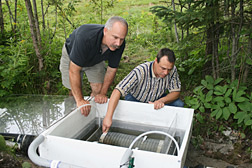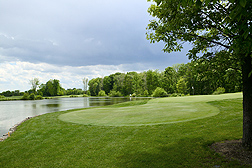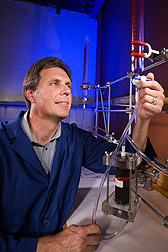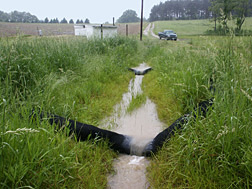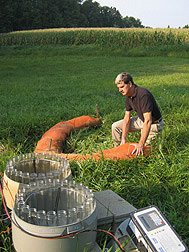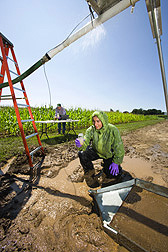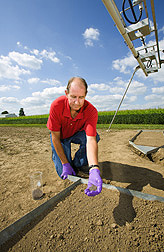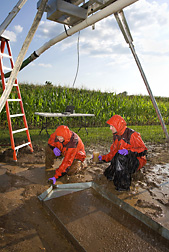From Golf to Gulf, Drainage Industry Greens
Scientists at six Agricultural Research Service (ARS) laboratories in five states are collaborating to bring three industries together with agribusiness to clean drainage water before it contributes to water-quality problems in the Gulf of Mexico and elsewhere.
The idea is to join forces for mutual benefit—using industrial products/byproducts from wallboard production, electric power plants, steel mills, water-treatment plants, foundries, and other industries to clean drainage water. The industries benefit from having an alternative to landfilling their byproducts. In turn, they benefit the drainage, farming, and turf industries by making sure the water they discharge downstream is clean for the next user as well as for the environment.
The focus for the turf industry is on golf courses, and one of the associations involved in this research is the U.S. Golf Association. Other collaborators include the Agricultural Drainage Management Coalition and the Industrial Resource Council.
|
|
Using Filters To Clean Golf Course Drainage Waters
A new idea being explored for cleansing drainage water from golf courses is to attach a filter cartridge to drainage-pipe outlets to neutralize nutrients and pesticides before they reach streams.
Kevin King, an agricultural engineer with the ARS Soil Drainage Research Unit (SDRU) in Columbus, Ohio, has spent the past 2 years testing commercial cartridges filled with the typical water cleansers used in drinking-water treatment plants and home aquariums.
As part of a national agreement between ARS and the U.S. Golf Association, King is testing the filters on a golf course in Waco, Texas. Water samples are tested for pesticides 2,4-D, chloro-thalonil, and metalaxyl and for phosphorus and nitrogen.
In cooperation with Agri Drain Corporation, near Adair, Iowa, KriStar Enterprises, Inc., in Santa Rosa, California, and Spectrum Research, Inc., in Duluth, Minnesota, King and colleagues at the ARS Pasture Systems and Watershed Management Research Unit in University Park, Pennsylvania, and Pennsylvania State University are also experimenting with the cartridges and other filter designs. Preliminary results are promising.
James C. Balogh, with Spectrum, and King installed the cartridge filters in a golf course tile drain in Duluth in August 2008. This is part of a larger golf course water-quality study. They’re evaluating the efficacy of the filter cartridges for reducing overall nutrients and chlorothalonil in the entire watershed surrounding the golf course.
King and colleagues are also testing wastewater-treatment residues, such as alum, to improve the ability of fairway vegetative buffer areas to filter out pollutants before they reach drainage-pipe outlets.
|
|
It Takes a Trench To Filter Farm Drainage
King’s colleague at Columbus, agricultural engineer Barry Allred, is testing industrial products/byproducts as filtering materials for water draining off farm fields, where filter cartridges aren’t practical. Instead, Allred would place filtering materials, such as coal-combustion byproducts, into an in-line treatment trench, so the water flowing from drainage pipes into the trench is cleansed before it reaches a stream.
Since 2007, Allred has batch tested 50 industrial products/byproducts as potential filter materials and has identified 5 of them as “quite promising.” He plans further testing of these materials in the laboratory.
“We also hope to do broader feasibility tests to address a variety of issues involved in using industrial products or byproducts,” he says. “These issues include the safety of the materials used—making sure we’re not substituting a worse contaminant for a lesser one, for example. We also have to make sure that the filtering doesn’t slow the drainage flow.”
Allred’s idea is to use industrial products/byproducts that are locally available in each state. “We have a lot of coal-burning power plants in Ohio, so a coal-combustion product such as high-carbon fly ash would be an inexpensive choice,” he says.
“Surfactant-treated zeolite, a water-purification compound, and sulfur-modified iron, a sulfur-iron mix made with a patented process, also show promise for removing nutrients and pesticides from agricultural and turf drainage waters,” Allred says.
At the University Park unit, scientists have been experimenting for nearly a decade with coal-combustion byproducts and other materials applied to soils or placed in ditches to treat runoff water. For the past 2 years, Ray Bryant, soil scientist and research leader, has tested gypsum byproduct, residual material from treating acid drainage from coal mines, and steel slag. The ditches in his studies drain fields that have been heavily manured and are key conduits of nutrients, particularly phosphorus. Bryant’s approach is to filter water moving through the ditches to capture phosphorus at critical points before it reaches the Chesapeake Bay.
“We’ve trapped up to 50 percent of the phosphorus in some drainage waters,” says Bryant.
In Beltsville, Maryland, agronomist Eton Codling, at the ARS Environmental Management and Byproduct Utilization Laboratory, found that drinking-water-treatment residuals and coal-bed ash reduced soluble phosphorus in two high-phosphorus soils by at least 50 to 90 percent. The residuals contained high aluminum and iron, and the coal-bed ash contained high calcium. These minerals bind to phosphorus, reducing its movement in the environment.
To determine the potential environmental impact of long-term use of these byproducts and the solubility of bound phosphorus under acidic conditions, Codling acidified both soils and grew several crops of bermudagrass. He found that phosphorus bound to the coal-bed ash became soluble over time, whereas phosphorus bound to the drinking-water-treatment residual did not.
Putting It All Together: Ditches, Wetlands, and Industry
Norm Fausey, SDRU soil scientist and research leader, and colleagues are working with faculty at Ohio State University in Columbus to plan the next phase of their research. They want to combine the best materials for all applications, including filter trenches for farm fields and cartridges for golf courses.
In Coshocton, Ohio, Martin Shipitalo, a soil scientist with the ARS North Appalachian Experimental Watershed Unit, is testing compost-filled filter socks placed in grassed waterways. The waterways convey water from fields to streams, filtering out soil and other solids but doing little for dissolved solids like phosphorus. Last year Shipitalo installed two filter socks in each of four grassed waterways to capture the phosphorus.
“After seeing how compost alone does for a year, I will try adding iron residue from wastewater-treatment facilities to bind even more phosphorus to the compost,” he says.
King’s, Allred’s, and Bryant’s filtering systems would blend in well with Shipitalo’s filter socks and the SDRU’s Wetland Reservoir Subirrigation Systems (WRSIS), developed by Fausey, Allred, and colleagues at Ohio State University. The team constructs wetlands near farm fields to cleanse drainage water of nitrate and eroded soil. The water is then stored in a reservoir and used for irrigation later in the summer. The irrigation is done by reversing the flow of water in underground plastic corrugated pipes used to drain fields in early spring. WRSIS could easily be used with golf courses, since they already have reservoirs to store water for irrigation.
Results from 2003 through 2007 at three sites in northern Ohio show that two of the three wetlands were very effective in removing sediment, nitrate, and total nitrogen. “Besides providing new wildlife habitat and flood control, the wetlands and reservoirs also have water-quality benefits and help increase crop yields,” Fausey says.
By further filtering the drainage water through industrial products/byproducts or other materials, “we could polish off the wetland’s filtering process, taking care of anything that may have slipped through,” Fausey says.
|
|
Pelletizing PAM
ARS soil scientist Darrell Norton’s research should also cleanse and conserve water on farm fields and golf courses. Norton, from the USDA National Soil Erosion Research Laboratory at West Lafayette, Indiana, has found a way to pelletize polyacrylamide (PAM) and gypsum byproducts together so farmers can apply them more easily. PAM is typically dissolved in water and applied to soil, and gypsum is applied as a powder. Not only were Norton’s pellets easier to apply, they also reduced erosion just as well as the typical treatments—25 to 50 percent compared to untreated soil—and increased water infiltration, thus saving more rain for crop use.
Gypsum-PAM pellets can also be useful for temporary erosion control while establishing permanent vegetative cover on highway embankments and landfill caps and in earthen channels like those found in crop fields or around ponds or dams.
The recommendation from the study is to apply gypsum-PAM pellets at a rate of about half a ton per acre.
Norton and colleagues began ARS’s PAM research in the early 1990s. PAM has been very successful for erosion control in irrigated areas because it does best in a very dilute solution of water, which fits irrigation perfectly. In rainy areas, however, “farmers would not irrigate just to apply PAM, because too much rain is why they need erosion control in the first place,” Norton says.
The large volume of gypsum coming out of power plants encourages Norton that it will be used increasingly on farms. There are already places nationwide that grind up used wallboard and sell the gypsum powder to farmers and landscapers.
The gypsum-PAM pellets cost about $120 a ton, making them much more affordable than traditional erosion-control materials used by highway departments and construction crews. Commercial erosion-control practices, such as land grading and application of mulches and fiber mats, usually cost about $100 to treat just 1 square yard of land.
Farmers are increasingly realizing that helping their crops capture more rainwater can help their yields as much as extra fertilizer can. Gypsum-PAM pellets cost less per acre of land treated than commercial fertilizers do. Pellets could also be used to compensate for the loss of some crop residue removed for ethanol production.
Pam Rice, a chemist with the ARS Soil and Water Management Research Unit at St. Paul, Minnesota, and colleagues at the University of Minnesota-St. Paul, will study chemical changes caused by gypsum in waters draining from turfgrass field plots.—By Don Comis and Jan Suszkiw, Agricultural Research Service Information Staff.
This research is part of Water Availability and Watershed Management (#211), Agricultural System Competitiveness and Sustainability (#216), and Crop Production (#305), three ARS national programs described on the World Wide Web at www.nps.ars.usda.gov.
To reach scientists mentioned in this article, contact Don Comis, USDA-ARS Information Staff, 5601 Sunnyside Ave., Beltsville, MD 20705-5129; phone (301) 504-1625, fax (301) 504-1486.
"From Golf to Gulf, Drainage Industry Greens" was published in the January 2009 issue of Agricultural Research magazine.







